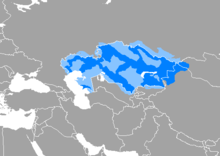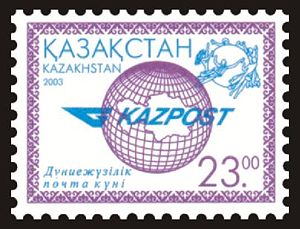Kazakh language - Simple English Wikipedia, the free encyclopedia
| Kazakh | |
|---|---|
| qazaqşa or qazaq tılı қазақша or қазақ тілі قازاقشا or قازاق تىلى | |
| Pronunciation | qɑzɑqˈɕɑ qɑˈzɑq tɘlɘ |
| Native to | Kazakhstan, China, Mongolia, Altai Republic (Russia), Kyrgyzstan, Uzbekistan, Iran, Pakistan, Azerbaijan, Turkey, Serbia, Romania, Greece, Moldova, Ukraine, Bulgaria |
| Region | Central Asia (Turkestan) |
| Ethnicity | Kazakhs |
Native speakers | 22 million (2019)[1] |
Turkic
| |
| Kazakh alphabets (Latin script, Cyrillic script, Arabic script, Kazakh Braille) | |
| Official status | |
Official language in |
Organisations: |
| Regulated by | Kazakh language agency |
| Language codes | |
| ISO 639-1 | kk |
| ISO 639-2 | kaz |
| ISO 639-3 | kaz |
| Glottolog | kaza1248 |
| Linguasphere | 44-AAB-cc |
 The Kazakh-speaking world: regions where Kazakh is the language of the majority regions where Kazakh is the language of a significant minority | |

Kazakh is a Turkic language that is mostly spoken in Kazakhstan, a country in Central Asia. It, along with Russian, is one of Kazakhstan's official languages.[3]
History
[change | change source]The Kazakh language had been written in the Cyrillic alphabet since the Russian Empire started to occupy that country in the 19th century. In 1917, people began to use the Arabic alphabet, but the Russians were not able to make them use Cyrillic.[4]
The Kazakhs used the Arabic script to write their language until approximately 1929. In the early 1900s, Kazakh activist Ahmed Baytursinuli reformed the Kazakh-Arabic alphabet, but his work was largely overshadowed by the Soviet presence in Central Asia. At that point, the new Soviet regime forced the Kazakhs to use a Latin script, and then a Cyrillic script in the 1940s in an effort to thoroughly Russify them. Today, Kazakhs use the Arabic, Latin, and Cyrillic scripts to write their language.[5]
Following the dissolution of the Soviet Union in 1991, the newly-independent Republic of Kazakhstan allowed the old Latin alphabet to be used, but continued to use Cyrillic as the main alphabet. In 2006, president Nursultan Nazarbayev started a project to introduce a standard form of the Latin alphabet as the official script of his country. A version of the new Latin alphabet, which used apostrophes for certain sounds, was created in April 2017,[6] but was replaced with another one in February 2018 which instead uses diacritics on certain letters.[7] The latest version, proposed in 2021, has been in official use and will be taught in elementary schools starting 2023. If all goes as planned, the Cyrillic alphabet will be fully replaced with Latin by 2025.[8]
Kazakh letters
[change | change source]The last proposed Kazakh Latin alphabet was shown in 2019:
| A a | Ä ä | B b | D d | E e | F f | G g | Ğ ğ | H h | İ i | I ı | J j | K k | L l | M m | N n | Ñ ñ | O o | Ö ö | P p | Q q | R r | S s | Ş ş | T t | U u | Ū ū | Ü ü | V v | Y y | Z z |
Sources
[change | change source]- ↑ "Kazakh".
- ↑ "Статья 4. Правовое положение языков | ГАРАНТ".
- ↑ Hays, Jeffrey. "LANGUAGES IN KAZAKHSTAN | Facts and Details". factsanddetails.com. Retrieved 2018-10-28.
- ↑ "The Language Called Kazakh". One Hour Translation. Retrieved 2018-10-28.[permanent dead link]
- ↑ "Нұрсұлтан Назарбаев. Болашаққа бағдар: рухани жаңғыру". web.archive.org. 2017-06-28. Archived from the original on 2017-06-28. Retrieved 2023-03-09.
- ↑ "Kazakhstan's switch from Cyrillic to Latin is about more than just alphabets". Public Radio International. Retrieved 2018-10-28.
- ↑ "Kazakh President Drops Apostrophes In New Latin Alphabet". RadioFreeEurope/RadioLiberty. Retrieved 2018-10-28.
- ↑ "Kazakhstan to switch to Latin alphabet by 2025 - The Astana Times". The Astana Times. 2017-10-31. Retrieved 2018-10-28.
Other websites
[change | change source]- Website of the government of Kazakhstan Archived 2012-05-19 at the Wayback Machine (in Kazakh)


 French
French Deutsch
Deutsch